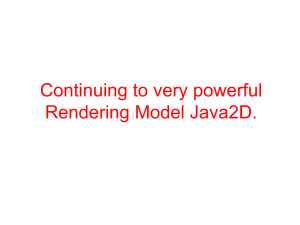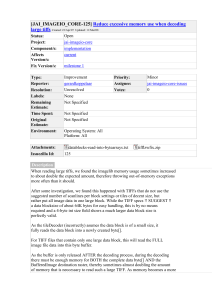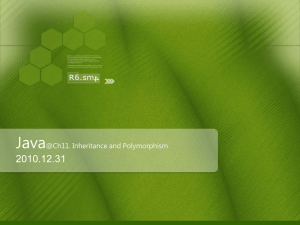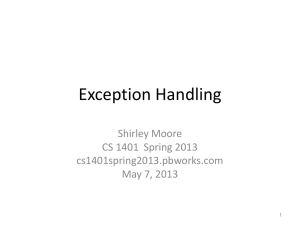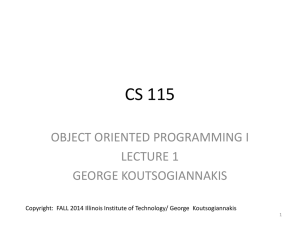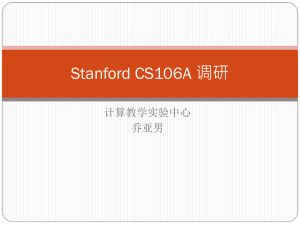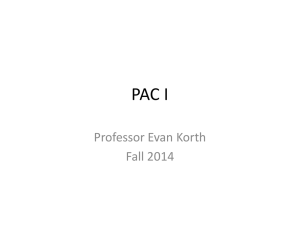Java image processing library
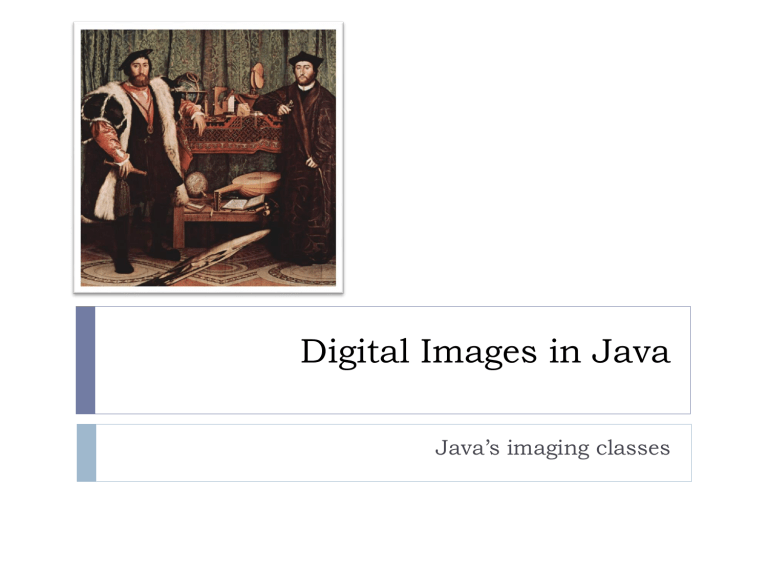
Digital Images in Java
Java’s imaging classes
Java imaging library
Java has good support for image processing
Must master a handful of classes and methods for performing inmemory image processing operations.
These classes are given in the UML diagram below.
The BufferedImage
WritableRaster
BufferedImageOp are the central classes.
2
BufferedImage
The BufferedImage class
Defined in the java.awt.image package
Represents an image that is stored entirely in memory
Similar to the concept of the DigitaImage interface we presented earlier
Is flexible in terms of color model and the way in which samples are represented
Can always convert into RGB space even if the data is in another color space
3
BufferedImage methods
Note that the ‘getRGB’ takes a column and row (x,y) and returns the packed pixel. ‘setRGB’ is symmetric.
Also note that to create a BufferedImage, an image type must be specified.
The type designates the transfer type (byte, short, int)
The type also designates the color model
Some common types are predefined
4
How to create a BufferedImage
Consider making images with the BufferedImage constructor
The first expression creates an all-black 250 column by 300 row grayscale image where each sample is a byte
The second expression creates an all-black 400 column by 100 row color image where each sample is packed into an int
Note that the BufferedImage class doesn’t support methods that allow individual samples of a BufferedImage to be read or
written!
5
ColorModel
The primary task of the ColorModel is to analyze a pixel and extract the individual color components red, green, and blue, for example.
Also supports CMY, HSB or any other color model that you choose to develop
ColorModel is an abstract class with subclasses that support packed pixel data (PackedColorModel) indexed pixel data (IndexColorModel) direct representation of samples (ComponentColorModel).
Since the RGB color space is the most common in general computing systems, RGB serves as a default. All ColorModels are able to convert from their native format to packed int
RGB format.
6
java.awt.image.WritableRaster
Each BufferedImage contains a WritableRaster
Represents a two-dimensional array of pixels but is actually a one-dimensional array internally.
Similar to the LinearizedDigitalImage implementation.
A WritableRaster is the object that contains the actual sample data. (Actually the
DataBuffer does, but that’s another story)
Sample data is read and written through the WritableRaster class.
7
javax.imageio.ImageIO
Often need to read a BufferedImage from a file or write a BufferedImage to a file
The ImageIO class provides static methods for reading and writing images
The ImageIO class supports PNG, JPEG, BMP and GIF formats.
It is important to understand that once the file is read and a BufferedImage constructed, there is no longer any connection between the BufferedImage and file.
While the BufferedImage that is created by the read method is an accurate depiction of the image file, there is no correlation between the representation of the BufferedImage and the file itself.
The file, for example, may use an indexed color model given in YCbCr color space while the BufferedImage may use a direct color model given in RGB space.
8
Example
Here is a code fragment that shows how the previous classes may be used to invert an image. The input image was created from a PNG file while the output image is saved as JPEG.
9
BufferedImageOp
The previous example is typical of single-source image processing operations
Single-source means that there is one image that is being processed
The operation creates a destination image
The source image is not modified but is used to create the destination
This process is represented in Java by the BufferedImageOp class
10
BufferedImageOp
The filter method accepts a BufferedImage source and destination.
If the destination is null, then a destination is created via the ‘createCompatibleDestImage’ method.
The source image is usually not modified
The other methods are often not used and will not be described in any detail.
Custom classes for code simplification
Consider the common pattern of iterating over the samples of an image using Java's library.
The three nested loops are
Lots of code to write
Error-prone since the
Nesting order can be important
Incorrect boundaries of the loops are easy to introduce via copy-and-paste
Order of the indices in the getSample method can be easily confused.
12
Custom classes for code simplification
imaging.scanners.Location
This text uses some custom classes to simplify image processing patterns.
The Location class wraps the three indices of a sample (column, row, and band) into a single object.
Notice that the attributes are public
13
Custom classes for code simplification
imaging.scanners.RasterScanner
A scanner is an iterator that traverses all of the Locations in an image in some well defined sequence.
The RasterScanner traverses the locations in top-to-bottom left-to-right fashion.
The source code of the RasterScanner is not presented but the scanner class is easy to use.
The code below replaces the three nested-loop pattern.
Should be understood as “for every sample s in image src, process s and place it into
the destination”.
Note that the ‘true’ in the constructor indicates whether or not bands are to be included in the iteration.
14
Custom classes for code simplification
imaging.ops.NullOp
Consider implementing the BufferedImageOp class
Must author a handful of methods
Lets write a very basic op that does nothing but “copy”
Call this operation the NullOp. Can then use this NullOp as a base class for many other
‘real’ operations.
Custom classes for code simplification
imaging.ops.NullOp
Consider implementing the BufferedImageOp class
These methods must be provided but are often not used.
Note that the getBounds returns the bounding rectangle of the source image,
Note that getPoint2D maps a source location to a destination location (useful for geometric ops) rendering hints may be effectively ignored.
Custom BufferedImageOp
The NullOp will now serve as a base class for most image processing operations presented in this text.
Subclasses will often need to include an overloaded ‘filter’ method and nothing else!
Consider taking the ‘inverse’ code presented earlier and refactoring the code as a NullOp subclass.
Using a BufferedImageOp
Using the BufferedImageOp
This code effectively replaces the code of listing 4.9
18
Displaying BufferedImages
Often want to see an image on the screen.
The imaging.gui.ImageComponent class can be used to display a BufferedImage
ImageComponent is a subclass of Component and so can be used in any Swingbased application
19
![[#JAI_CORE-78] Problem with using filestore to save a cropped tiled](http://s3.studylib.net/store/data/007289744_1-05c1cc94c3324d9110d803c3357db7a1-300x300.png)
